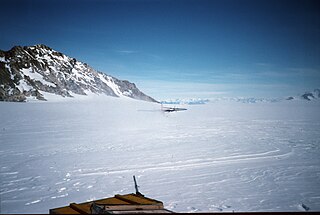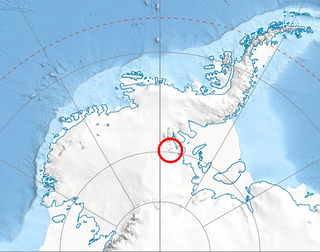
The Neptune Range is a mountain range, 112 km (70 mi) long, lying WSW of Forrestal Range in the central part of the Pensacola Mountains in Antarctica. The range is composed of Washington Escarpment with its associated ridges, valleys and peaks, the Iroquois Plateau, and the Schmidt and Williams Hills. It was discovered and photographed on January 13, 1956 on a US Navy transcontinental plane flight from McMurdo Sound to Weddell Sea and return.

The Prince Charles Mountains are a major group of mountains in Mac. Robertson Land in Antarctica, including the Athos Range, the Porthos Range, and the Aramis Range. The highest peak is Mount Menzies. Other prominent peaks are Mount Izabelle and Mount Stinear. These mountains together with other scattered peaks form an arc about 260 miles long, extending from the vicinity of Mount Starlight in the north to Goodspeed Nunataks in the south.

Athos Range is the northernmost range in the Prince Charles Mountains of Mac. Robertson Land, Antarctica. The range consists of a large number of individual mountains and nunataks that trend east-west for 40 miles (60 km) along the north side of Scylla Glacier.

The Auriga Nunataks are a small group of nunataks in Palmer Land, Antarctica, located 21 miles (34 km) east of Wade Point at the head of Bertram Glacier. The highest of these rises to a sharp peak and is visible for a great distance. They were named by the UK Antarctic Place-Names Committee after the constellation of Auriga.
The Alexander Nunataks are two coastal nunataks at the southern limit of the Windmill Islands, standing on the shore of Penney Bay 0.4 nautical miles (0.7 km) east of the base of the Browning Peninsula. They were first mapped from air photos taken by U.S. Navy Operation Highjump and Operation Windmill in 1947 and 1948, and named by the Advisory Committee on Antarctic Names for Photographer's Mate H.N. Alexander, a member of one of the two Operation Windmill photographic units that obtained air and ground photos of the area in January 1948.

Aphrodite Glacier is a glacier 15 nautical miles (28 km) long flowing north to the east coast of the Antarctic Peninsula 3 nautical miles (6 km) west of Victory Nunatak. The lower portion of the feature was first plotted by W.L.G. Joerg from aerial photographs taken by Sir Hubert Wilkins in December 1928 and by Lincoln Ellsworth in November 1935. The glacier was subsequently photographed by the Ronne Antarctic Research Expedition in December 1947 and surveyed by the Falkland Islands Dependencies Survey in December 1958 and November 1960. It was named by the UK Antarctic Place-Names Committee after Aphrodite, the goddess of love in Greek mythology.
Butcher Nunatak is a nunatak at the south end of the Birchall Peaks, 4 nautical miles (7 km) southwest of Swarm Peak, in the Ford Ranges of Marie Byrd Land. It was mapped by the United States Geological Survey from surveys and from U.S. Navy air photos (1959–65), and named by the Advisory Committee on Antarctic Names for Robert S. Butcher, builder, U.S. Navy, at Byrd Station in 1967.
The Church Nunataks are a line of small nunataks 1 nautical mile (2 km) northeast of Mount Smethurst and 28 nautical miles (52 km) southwest of the Stor Hanakken Mountain in Enderby Land. They were plotted from air photos taken from Australian National Antarctic Research Expeditions aircraft in 1957, and named by the Antarctic Names Committee of Australia for S.W. Church, radio officer at Wilkes Station in 1961.
Coal Nunatak is a flat-topped rock mass with steep cliffs facing south, standing 2 nautical miles (4 km) southwest of Corner Cliffs on the southeast coast of Alexander Island, Antarctica. It was first seen from the air by Lincoln Ellsworth on November 23, 1935, and mapped from photos obtained on that flight by W.L.G. Joerg. Observed from the northwest, only the summit protrudes above the coastal ice, and it was uncertain whether this was a peak on Alexander Island or an island in George VI Sound. Its true nature was determined by the Falkland Islands Dependencies Survey (FIDS) who visited and surveyed this nunatak in 1949. So named by FIDS because thin lenses of coal occur there.
Natani Nunatak is a nunatak 1.5 nautical miles (2.8 km) north-northeast of the extremity of Snake Ridge in the Patuxent Range, Pensacola Mountains. Mapped by United States Geological Survey (USGS) from surveys and U.S. Navy air photos, 1956-66. Named by Advisory Committee on Antarctic Names (US-ACAN) for Kirmach Natani, biologist at South Pole Station, winter 1967.
Warren Nunatak is a nunatak located 4 nautical miles (7 km) east of Mount Capley, along the east side of the Nimbus Hills in the Heritage Range. Mapped by United States Geological Survey (USGS) from surveys and U.S. Navy air photos, 1961-66. Named by Advisory Committee on Antarctic Names (US-ACAN) for Arthur D. Warren, auroral scientist at Ellsworth Station in 1958.
Dirtbag Nunatak is a ridge-like nunatak rising to 940 metres (3,080 ft), 3.5 nautical miles (6 km) south-southwest of Mount Manke, in the Harold Byrd Mountains in Antarctica. The feature was mapped by the United States Geological Survey from ground surveys and U.S. Navy aerial photographs, 1960–63. It was visited in 1977–78 by a United States Antarctic Research Program – Arizona State University geological party, led by Edmund Stump, and named in the spirit of Coalsack Bluff, as thin lenses of disintegrating mica and schist form a type of light soil on the slopes of the nunatak.

Gowan Glacier is a glacier about 15 nautical miles long in the Heritage Range of the Ellsworth Mountains of Antarctica, flowing north from the vicinity of Cunningham Peak in the Founders Escarpment to enter Minnesota Glacier just east of Welcome Nunatak. It was mapped by the United States Geological Survey from surveys and U.S. Navy air photos, 1961–66, and was named by the Advisory Committee on Antarctic Names for Lieutenant Jimmy L. Gowan, U.S. Navy Medical Corps, officer in charge and doctor at Plateau Station in 1966.
The Franck Nunataks are a scattered group of small rock outcrops, 3 nautical miles (6 km) in extent, at the base of the Beethoven Peninsula in the southwest part of Alexander Island, Antarctica. They were first mapped from air photos taken by the Ronne Antarctic Research Expedition, 1947–48, by D. Searle of the Falkland Islands Dependencies Survey in 1960. They were named by the UK Antarctic Place-Names Committee after César Franck, the French composer, 1822-1890.
The Lister Nunataks are isolated nunataks located in the northern reaches of Priestley Névé, about 15 nautical miles (28 km) south-southwest of the Brawn Rocks, in Victoria Land, Antarctica. They were mapped by the United States Geological Survey from surveys and U.S. Navy air photos, 1960–64, and were named by the Advisory Committee on Antarctic Names for Larry W. Lister, a helicopter flight crewman with U.S. Navy Squadron VX-6 during Operation Deep Freeze 1966, 1967 and 1968.
Higgins Nunatak is the largest of the Samuel Nunataks, lying near the south end of this group in the Heritage Range in Antarctica. It was mapped by the United States Geological Survey from surveys and U.S. Navy air photos, 1961–66, and was named by the Advisory Committee on Antarctic Names for utilitiesman John C. Higgins, U.S. Navy, a member of the McMurdo Station party during Operation Deep Freeze 1966.
Henkle Peak is a peak about 15 nautical miles (30 km) north of Mount Rex in Palmer Land, Antarctica. It lies among a group of nunataks that were first sighted and photographed by Lincoln Ellsworth on November 23, 1935. The peak was mapped by the United States Geological Survey (USGS) from surveys and U.S. Navy air photos, 1961–66, and was named by the Advisory Committee on Antarctic Names for Charles R. Henkle of USGS, a topographic engineer with the Marie Byrd Land Survey Party, 1967–68.
Kelley Nunatak is a nunatak on the north side of Leverett Glacier in Antarctica, 12 nautical miles (22 km) northeast of Mount Gould. It was mapped by the United States Geological Survey from ground surveys and U.S. Navy air photos, 1960–63, and was named by the Advisory Committee on Antarctic Names for Herbert O. Kelley, a radioman with the Byrd Station winter party in 1958.
Recluse Nunatak is an isolated rock exposure lying on the Handel Ice Piedmont, midway between Haydn Inlet and the Colbert Mountains in the west-central portion of Alexander Island, Antarctica. The nunatak was first mapped from air photos taken by the Ronne Antarctic Research Expedition (RARE), 1947–48, by Searle of the Falkland Islands Dependencies Survey (FIDS) in 1960. The name given by the United Kingdom Antarctic Place-Names Committee (UK-APC) suggests the isolated position of the nunatak, considering this landform is situated far away from other landforms of Alexander Island.






